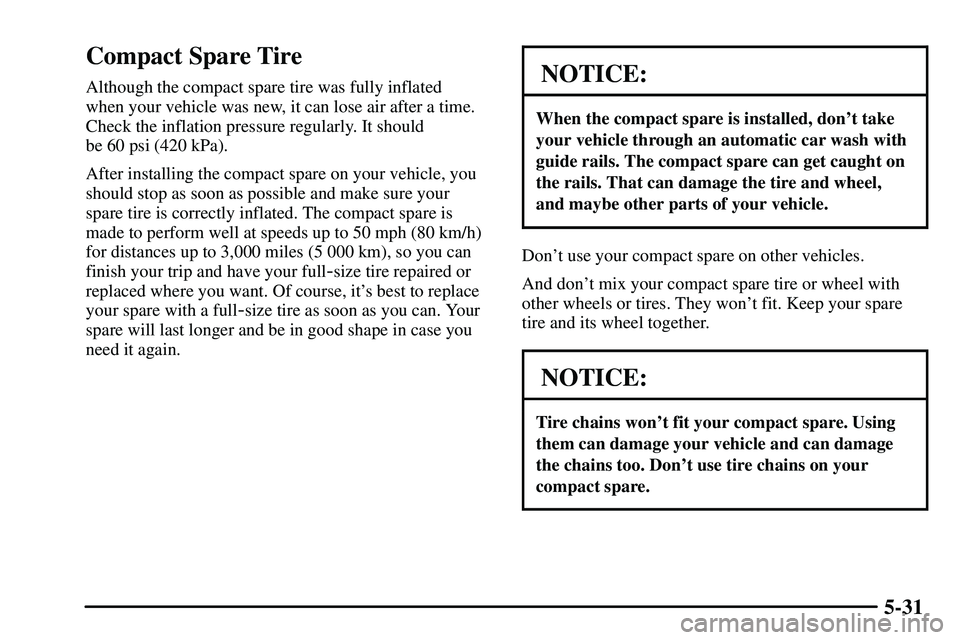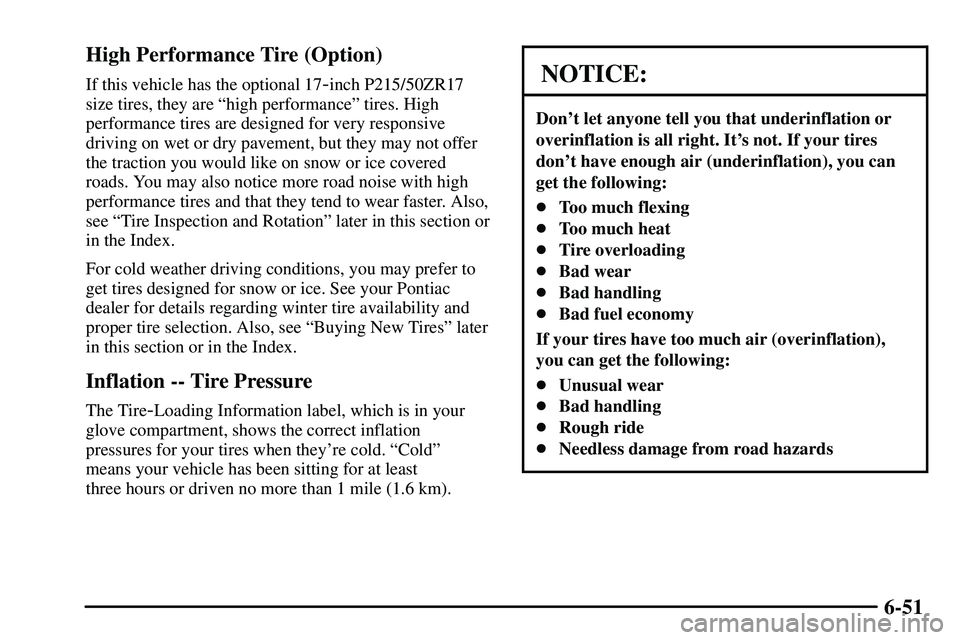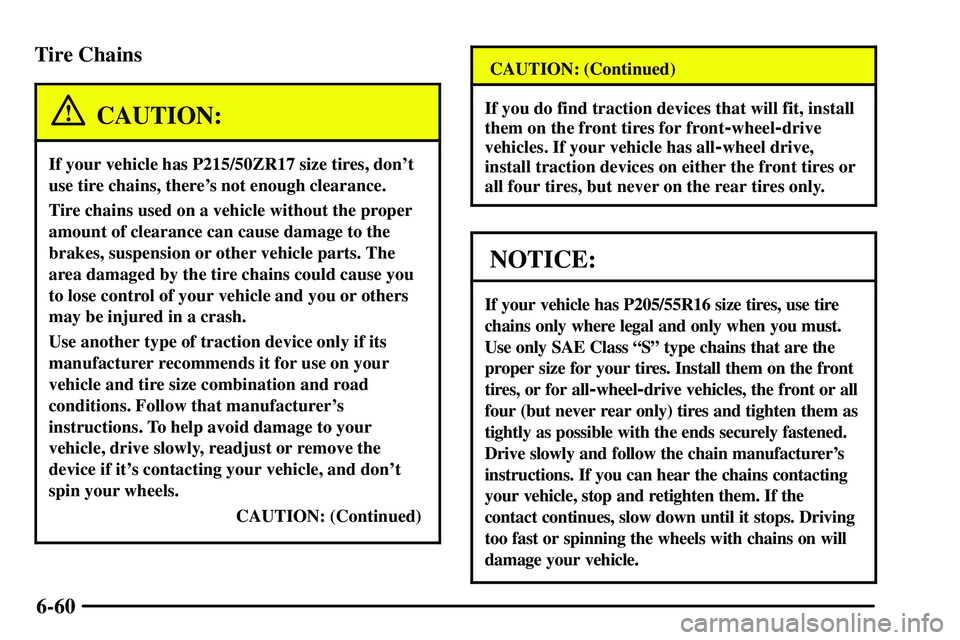Page 202 of 381
4-34
Loading Your VehicleThe Tire-Loading Information/Certification label on
your vehicle, located in the glovebox, shows how much
weight it may properly carry. The Tire
-Loading
Information label tells you the proper size, and
recommended inflation pressures for the tires on your
vehicle. It also gives you important information about
the number of people that can be in your vehicle and the
total weight that you can carry. This weight is called the
Vehicle Capacity Weight, and includes the weight of all
occupants, cargo and all nonfactory
-installed options.
Page 242 of 381

5-31
Compact Spare Tire
Although the compact spare tire was fully inflated
when your vehicle was new, it can lose air after a time.
Check the inflation pressure regularly. It should
be 60 psi (420 kPa).
After installing the compact spare on your vehicle, you
should stop as soon as possible and make sure your
spare tire is correctly inflated. The compact spare is
made to perform well at speeds up to 50 mph (80 km/h)
for distances up to 3,000 miles (5 000 km), so you can
finish your trip and have your full
-size tire repaired or
replaced where you want. Of course, it's best to replace
your spare with a full
-size tire as soon as you can. Your
spare will last longer and be in good shape in case you
need it again.
NOTICE:
When the compact spare is installed, don't take
your vehicle through an automatic car wash with
guide rails. The compact spare can get caught on
the rails. That can damage the tire and wheel,
and maybe other parts of your vehicle.
Don't use your compact spare on other vehicles.
And don't mix your compact spare tire or wheel with
other wheels or tires. They won't fit. Keep your spare
tire and its wheel together.
NOTICE:
Tire chains won't fit your compact spare. Using
them can damage your vehicle and can damage
the chains too. Don't use tire chains on your
compact spare.
Page 296 of 381

6-51 High Performance Tire (Option)
If this vehicle has the optional 17-inch P215/50ZR17
size tires, they are ªhigh performanceº tires. High
performance tires are designed for very responsive
driving on wet or dry pavement, but they may not offer
the traction you would like on snow or ice covered
roads. You may also notice more road noise with high
performance tires and that they tend to wear faster. Also,
see ªTire Inspection and Rotationº later in this section or
in the Index.
For cold weather driving conditions, you may prefer to
get tires designed for snow or ice. See your Pontiac
dealer for details regarding winter tire availability and
proper tire selection. Also, see ªBuying New Tiresº later
in this section or in the Index.
Inflation -- Tire Pressure
The Tire-Loading Information label, which is in your
glove compartment, shows the correct inflation
pressures for your tires when they're cold. ªColdº
means your vehicle has been sitting for at least
three hours or driven no more than 1 mile (1.6 km).
NOTICE:
Don't let anyone tell you that underinflation or
overinflation is all right. It's not. If your tires
don't have enough air (underinflation), you can
get the following:
�Too much flexing
�Too much heat
�Tire overloading
�Bad wear
�Bad handling
�Bad fuel economy
If your tires have too much air (overinflation),
you can get the following:
�Unusual wear
�Bad handling
�Rough ride
�Needless damage from road hazards
Page 299 of 381
6-54
When It's Time for New Tires
One way to tell when it's
time for new tires is to
check the treadwear
indicators, which will
appear when your tires have
only 1/16 inch (1.6 mm) or
less of tread remaining.You need a new tire if any of the following statements
are true:
�You can see the indicators at three or more places
around the tire.
�You can see cord or fabric showing through the
tire's rubber.
�The tread or sidewall is cracked, cut or snagged deep
enough to show cord or fabric.
�The tire has a bump, bulge or split.
�The tire has a puncture, cut or other damage that
can't be repaired well because of the size or location
of the damage.
Page 300 of 381
6-55 Buying New Tires
To find out what kind and size of tires you need, look at
the Tire
-Loading Information label.
Make sure the replacements are the same size, load
range, speed rating and construction type (bias,
bias
-belted or radial) as your original tires.
CAUTION:
Mixing tires could cause you to lose control while
driving. If you mix tires of different sizes or types
(radial and bias
-belted tires), the vehicle may not
handle properly, and you could have a crash.
Using tires of different sizes may also cause
damage to your vehicle. Be sure to use the same
size and type tires on all wheels.
It's all right to drive with your compact spare,
though. It was developed for use on your vehicle.
CAUTION:
If you use bias-ply tires on your vehicle, the
wheel rim flanges could develop cracks after
many miles of driving. A tire and/or wheel could
fail suddenly, causing a crash. Use only radial
-ply
tires with the wheels on your vehicle.
Page 305 of 381

6-60 Tire Chains
CAUTION:
If your vehicle has P215/50ZR17 size tires, don't
use tire chains, there's not enough clearance.
Tire chains used on a vehicle without the proper
amount of clearance can cause damage to the
brakes, suspension or other vehicle parts. The
area damaged by the tire chains could cause you
to lose control of your vehicle and you or others
may be injured in a crash.
Use another type of traction device only if its
manufacturer recommends it for use on your
vehicle and tire size combination and road
conditions. Follow that manufacturer's
instructions. To help avoid damage to your
vehicle, drive slowly, readjust or remove the
device if it's contacting your vehicle, and don't
spin your wheels.
CAUTION: (Continued)
CAUTION: (Continued)
If you do find traction devices that will fit, install
them on the front tires for front
-wheel-drive
vehicles. If your vehicle has all
-wheel drive,
install traction devices on either the front tires or
all four tires, but never on the rear tires only.
NOTICE:
If your vehicle has P205/55R16 size tires, use tire
chains only where legal and only when you must.
Use only SAE Class ªSº type chains that are the
proper size for your tires. Install them on the front
tires, or for all
-wheel-drive vehicles, the front or all
four (but never rear only) tires and tighten them as
tightly as possible with the ends securely fastened.
Drive slowly and follow the chain manufacturer's
instructions. If you can hear the chains contacting
your vehicle, stop and retighten them. If the
contact continues, slow down until it stops. Driving
too fast or spinning the wheels with chains on will
damage your vehicle.